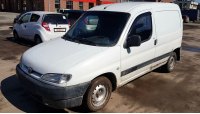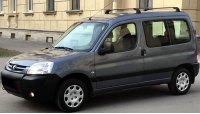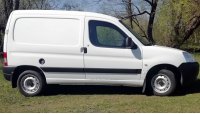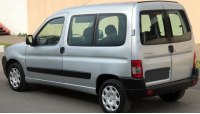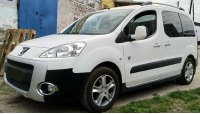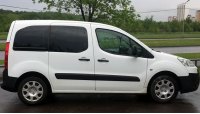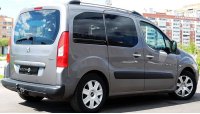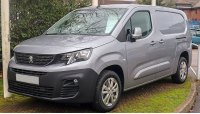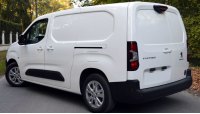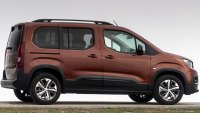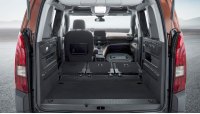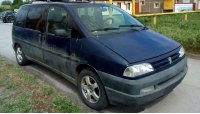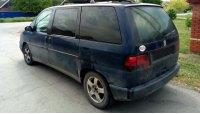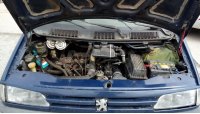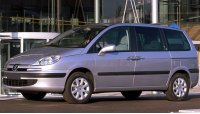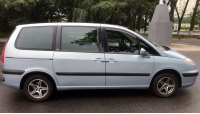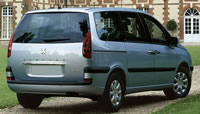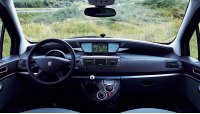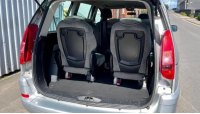Share information:
Peugeot Partner / Citroen Berlingo
Peugeot Partner - light-duty car van for the transport of goods and people (M segment), which is produced by the French automotive company «PSA Peugeot Citroën» from July 1996 to the present. Has a different name Citroen Berlingo. Passenger versions are called Berlingo Multispace and Partner Combi and there are five or seven seats. Replaced obsolete vans «Citroën C15» And «Citroën Visa».
The main competitors of Peugeot Partner are the following cars from other automakers - Kia Venga, Mercedes-Benz Citan, Opel Combo, Renault Kangoo, Skoda Roomster, Chevrolet Orlando, Honda Stream, Lada Largus, Toyota Sienta, Fiat Doblo and Volkswagen Caddy.
First generation (1996-2008)
The first generation was first shown at the Paris Motor Show in October 1996 and was produced until 2008. Already in 1997, the French company «Renault» releases a competitor «Kangoo» with a more modern design and a sliding rear side door that was not originally available «Partner» and which turned out to be very convenient. In 1999, «Berlingo» the same door appears on the right side for access to it from the sidewalk. After that «Renault Kangoo» equip with a second such door, but on the left. In the future, at «Berlingo» a door appears. The body was a four- or five-door van or five-door minivan with a length of 4135 mm, a width of 1820 mm, a height of 1725 mm and a curb weight of 1258 kg. In just 12 years, about 1.2 million cars were produced «Berlingo-Partner» first generation. In some countries, the first generation continues to be produced until now under the name «Berlingo First».
In December 2002, they carried out modernization, greatly changing the front of the car (the back remains the same), the headlights have become significantly larger, and the dashboard has also been heavily updated. Technical changes included strengthening the front shock absorbers, the possibility of transforming the cabin «Multispace», the advent of anti-lock braking system (ABS) and airbags. In the crash test of the European Committee «EuroNCAP» the updated car received four out of five stars. In 2004, another minor update was carried out.
The motor was located in front with front-wheel drive. The line of gasoline engines was a 1.4-liter four-cylinder in-line (1360 cm3, TU3, 74 hp), 1.6 liters (1587 cm3, TU5, 107 hp) and 1.8 liters (1761 cm3, PSA XU, 89 hp). Diesel also had a 1.6-liter four-cylinder (1560 cm3, DV6 HDi, 74-91 hp), 1.9 liters (1905 cm3, XUD, 70 hp), 1.9 liters (1868 cm3, DW8, 70 hp) and 2.0 liters (1997 cm3, DW10 HDi, 89 hp). The gearbox was installed only five-speed manual. There was also a purely electric version of the car with a 38 hp electric motor produced from 1998 to 2005.
Second generation (2008-2018)
Second generation «Partner» And «Berlingo» appeared in May 2008 and was produced until 2018. Platform based «PSA PF2», which is also used for «Citroën C4» And «Peugeot 308» first generation. The body is made in the form of a four- or five-door van, two-door pickup or five-door minivan. The length of the car was 4379-4628 mm, width 1810-2112 mm, height 1805-1840 mm and curb weight 1397-1429 kg. Assembly is carried out in Spain and Portugal.
The car is equipped with modern systems such as hill start assist, brake assist, height and depth adjustable steering wheel, opening rear flap, sliding side door, three independent and removable seats in the second row, manually folding mirrors, carpeting in the cabin and PVC mat in the trunk, tinted windows, etc. Coloring available as options «metallic», two sliding side doors on both sides, two glass hinged doors, an advanced audio system, etc. «Berlingo» the second generation received four stars out of a maximum of five in the crash tests of the European Committee «EuroNCAP».
There were three 1.2-liter petrol engines (1199 cm3, THP, 110 hp), 1.6 liters (1598 cm3, VTi, 98/120 hp) and 1.6 liters (1587 cm3, 90/110 hp). Diesel engines had two modifications of 1.6 liters (1560 cm3, HDi, 75/90/110 hp), which since 2015 has been replaced by 1.6 liters (1560 cm3, BlueHDi, 75/90/102/120 hp). The gearbox is only a five-speed manual. Again, a purely electric vehicle was produced for the transport of goods with an electric motor with a capacity of 67 hp. (49 kW). In 2017, a family electric car appeared for transporting passengers «E-Berlingo Multispace».
In 2012, the model was updated with the modification of some engines. In 2015, a second modernization was carried out, which, in addition to changing the appearance, brought all engines to the standard «Euro 6».
Third generation (2018-present time)
The third generation was presented in March 2018 at the Geneva Motor Show, as well as in April 2019 at the Commercial Vehicles Show in England. Sales began in June 2018. The vehicle names were as follows − «Peugeot Rifter», «Peugeot Partner III», «Citroën Berlingo III», «Opel Combo D» And «Toyota ProAce City». Platform based «PSA EMP2». The body was produced in two wheelbases - 2780 mm and 2970 mm, the total length of the car was 4403 mm and 4753 mm, width 1921 mm, height 1844 mm and curb weight 1431-1505 kg. Number of seats 5 or 7 depending on the wheelbase. Production was in Spain and Portugal.
There were two models of engines, one petrol three-cylinder with a volume of 1.2 liters (1199 cm3, BlueHdi) 110 hp and diesel four-cylinder with a volume of 1.5 liters (1499 cm3, Thp) 75, 102 and 130 hp. Gearbox six-speed manual or eight-speed automatic.
Peugeot Eurovan
Peugeot Eurovans - a family of large minivans produced by automakers Citroën, Peugeot, Lancia and Fiat from March 1994 to June 2014. It was a joint project between Fiat and PSA. There were two generations with names «Peugeot 806» And «Peugeot 807», cars of other brands were sold under the names «Citroën Evasion», «Citroën C8», «Lancia Zeta», «Lancia Phedra» And «Fiat Ulysse». Competitors this car are Chrysler Voyager, Chery Crosseastar, Hyundai Starex, Volkswagen Sharan, SEAT Alhambra, Ford Galaxy, Mazda 5, Mercedes-Benz Vito, Opel Zafira, Renault Espace and Toyota Previa.
First generation (Peugeot 806, 1994-2002)
The first generation was introduced in June 1994. The minivan was slightly smaller than the then popular Chrysler Voyager in Europe and had convenient sliding doors. Body length was 4460 mm, width 1820 mm. height 1710 mm, wheelbase 2820 mm and curb weight 1550-1750 kg. The seating configuration included two individual seats at the front and three individual removable seats in the middle, as well as a choice of two individual removable seats or one bench seat at the rear. The shift lever was mounted on the dashboard rather than on the floor. The handbrake was located to the left of the driver, which made it possible to make a passage between the front seats.
First generation used PSA engines «XU/XUD». Gasoline engines were of the following volumes and characteristics - 1.8 liters (1761 cm3, XU7, 99 hp), 2.0 liters (1998 cm3, XU10, 121/132/147 hp) and 2.0 liters (1997 cm3, EW10, 136 hp). Diesel engines were turbocharged with a volume of 1.9 liters (1905 cm3, XUD9, 90 hp), 2.0 liters (1997 cm3, DW10, 109 hp) and 2.1 liters (2088 cm3, XUD11, 109 hp). The gearbox on almost all models was a five-speed manual, and with a gasoline engine «EW» It was possible to choose a four-speed automatic.
In October 1998, a cosmetic facelift was carried out.
Second generation (Peugeot 807, 2002-2014)
Peugeot 807 began production in June 2002. The length of the car and other dimensions increased while maintaining the same wheelbase and amounted to 4750 mm, width 1854 mm, height 1752 mm, wheelbase 2823 mm and curb weight 1645-1837 kg. The increase in length significantly increased the volume of the cabin. The minivan received the maximum rating of 5 stars in the Euro NCAP crash test. Presented at the 2003 Geneva Motor Show «Peugeot 807 Grand Tourisme» with V6 engine. In total, more than 140 thousand were produced «Peugeot 807» second generation.
Petrol four-cylinder engines were 2.0 liters (1997 cm3, EW10, 136/140 hp) and 2.2 liters (2230 cm3, EW12, 158 hp), 3.0-liter six-cylinder V6 (2946 cm3, ES9, 207 hp). Diesel engines are all four-cylinder turbocharged 2.0-liter (1997 cm3, DW10, 109/120/136 hp) and 2.2 liters (2179 cm3, DW12, 128/170 hp). Gearboxes are the same - a four-speed automatic or a five-speed manual.
In 2006, the car began to comply with the Euro 4 emission standard. In February 2008, they carried out an external restyling of the model and added a 2.2-liter twin-turbo diesel. In 2012, another facelift took place.

